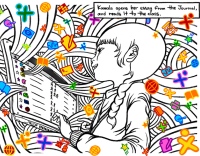The design of the Sugar Labs logo was an opportunity to create a coherent visual identity for both the revolutionary educational software and also the organization behind it - a growing community of volunteers from diverse backgrounds and professional disciplines.
A simple, typographic approach was used for the logo to set it apart from the primarily iconographic Sugar. The conceptual link to the user interface is color, applied to the letterforms through an outline and an interior color - the same technique used to represent identity in the interface for icons of children and activities.
Twelve possible color combinations speak to the diversity of the Sugar Labs community. Used to distinguish sites within the Sugar Labs network, such as the Sugar Activities portal and the Planet Sugar blog, color also served as conceptual direction for the design of the main website.
While the wiki is an essential communication platform for community members, a "static" website was needed for conveying basic information to the general public and the two main target groups--parents and teachers. The objective was to design a highly functional website that clearly communicated the goals and philosophy behind Sugar and Sugar Labs, and directed interested people to the wiki or related content hosted on other sites within the Sugar Labs network.
From an aesthetic standpoint, the static website provided another opportunity to extend the visual language introduced with the logo. While other sites within the Sugar Labs network use a specific logo and color combination, www.sugarlabs.org is conceptually represented as the "umbrella" site by not conforming to a single color scheme, but instead incorporating all colors. The website playfully interprets this notion by displaying a different color combination every time a page is visited.
A highlight of the new website is a graphic narrative illustrated by Dongyun Lee that communicates the vision for how children will use (and in many cases are already using) Sugar in the classroom and at home.
Visually, Dongyun imagines Sugar as a pervasive and unbounded medium--separate from any particular device or physical location--creating connections and new possibilities for interaction among children."
Christian Marc Schmidt is currently a senior designer at Pentagram in New York, where he helped design the Sugar user interface together with Lisa Strausfeld and her team.



